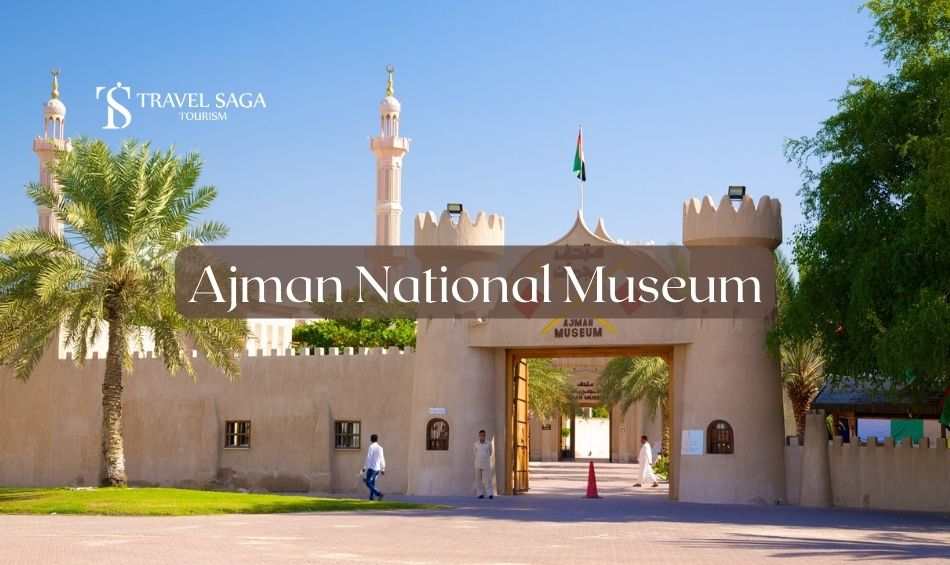Ajman National Museum

Ajman is considered the smallest of all the Emirates in the UAE but is known to accommodate some of the finest heritage sites across the country. Among the various, the Ajman National Museum is a place worth visiting. The Ajman National Museum is also referred to as the Ajman Fort Museum and was built using gypsum and coral stones for the structural feats here.
The fort renovations started under the leadership of Sheikh Rashid Bin Humaid around the year 1838. The museum now houses early manuscripts, ancient wooden dhow boats, and efficient irrigational systems within the complex.
Let us check the basic history and facts at the proper time to visit the Ajman National Museum here in Ajman.
History
The Ajman National Museum once used to be a fort around the coastal areas of Ajman. It was around 1816 when Sheikh Nuaimi defeated the Al Bu Shamis and captured the fort under the circumstances. From then on, the fort became a household for the ruling family until it was renovated into a museum. The fort once acted as the first line of defense from the invaders and terrorists here, with watchtowers and windmills around the place. The entrance is guarded by a heavy metal gate with two cannons on either side of the entrance. The fort eventually acted as a police station between 1971 and 1975 and was later converted into a museum in 1981.
Things to Check out at the Ajman Museum

There are various artifacts and places to visit in Ajman relics to check out while visiting the Ajman Museum. There is ancient jewelry and pottery on exhibit, along with early pearl fishing tools and distinct manuscripts and tapestries. Among the varied things available to check out, a few of the important elements present at the museum are depicted below:
1. Pottery Artifacts
An ancient cemetery is present here, excavated in the Al Mowaihat area. It has the oldest jewellery and pottery artefacts from around 3,000 B.C. This place was accidentally excavated by construction workers, who found the first settlers of the Arab land here. The Al Mowaihat area is now a residential area for people, as are some of the excellent housing structures built around the location. Various ancient beads, painted jars, and conch shell buttons can be checked here, displayed over the exhibits.
2. Fishing and Pearl Farming Tools and Equipment
The Ajman Museum is also home to various fishing and pearl farming tools. They were used in the early societies of the Emirati land. The main trade for the Arabs used to be fishing and pearl farming. The museum displays the best artifacts used in the process. Replicas of the various early fishing scenes are created at the museum to help people learn about the various antics of the early Arab people. Therefore, during your UAE tour, experiencing all these things will make your every moment special.
3. Sculptures and Figurines
The Ajman Museum also houses some of the best sculptures and figurines from ancient times. Some figurines resemble the early lives of the Ajman people, with barbers and fishermen found throughout the place. The place also provides distinct light on the various police equipment and weapons used during the 1980s. Remnants of the first radio station built over the museum are still offered as an exhibit to visitors here.
4. The Best Time to Visit the Ajman National Museum
The Ajman National Museum can be visited at any time of the year since the exhibits are displayed within the interiors of the complex. If you wish to partake in distinct activities while visiting the Ajman National Museum here, then winter is the perfect time to enjoy it. Visitors can go fishing or enjoy the sandy beaches during this time of the year to avoid any kind of heat rash on the body.
How to Reach Ajman Museum?
The Ajman Museum can be reached from any place in the UAE. There are many transportation services like public buses and you can rent a car to reach the place here. The Corniche is quite near the Ajman Museum, making it a perfect spot to watch the landmarks here. Find Location On Map
Timing
The museum is open to visitors from Saturdays to Thursdays. Starting from 8 in the morning until 8 in the evening. Fridays are open for a half day, and visitational timings are between 2.30 P.M. and 8 P.M.
Entry Fee
The admission fee for Ajman Museum is AED 5 per person.
Conclusion
The above are a few important facts and histories considering the Ajman National Museum. Individuals can easily travel to the location using public lines from any place in the UAE. You can also visit the Museum of Future in Dubai. Check out the rich history and immerse yourself in the great traditional ways of the early Arab people here at the Ajman Museum.











